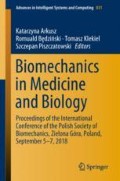Abstract
In this paper a research towards understanding of mechanics of ventral hernia operated with the use of Physiomesh implant and SecureStrap
implant and SecureStrap staples is described. Experimental and numerical studies are conducted for that purpose. Experimental works cover uni-axial tension tests of the implant samples and of the implant-staples-tissue system. Also experiments on implant-staples-tissue models, representing operated hernia, subjected to impulse pressure loading are performed. Based on that, constitutive model of the mesh has been identified and failure load of the staples has been determined. In the experiments on the operated hernia systems subjected to pressure loading safe loading level has been determined and failure modes connected to higher pressure values have been observed. Finally, in the numerical simulations of the operated hernia model, built according to FEM rules, it has been proved that failures observed experimentally result from exceeding of the load bearing capacity of the staples considered in this study.
staples is described. Experimental and numerical studies are conducted for that purpose. Experimental works cover uni-axial tension tests of the implant samples and of the implant-staples-tissue system. Also experiments on implant-staples-tissue models, representing operated hernia, subjected to impulse pressure loading are performed. Based on that, constitutive model of the mesh has been identified and failure load of the staples has been determined. In the experiments on the operated hernia systems subjected to pressure loading safe loading level has been determined and failure modes connected to higher pressure values have been observed. Finally, in the numerical simulations of the operated hernia model, built according to FEM rules, it has been proved that failures observed experimentally result from exceeding of the load bearing capacity of the staples considered in this study.
Access this chapter
Tax calculation will be finalised at checkout
Purchases are for personal use only
References
Pans, A., Elen, P., Dewé, W., Desaive, C.: Long-term results of polyglactin mesh for the prevention of incisional hernias in obese patients. World J. Surg. 22(5), 479–483 (1998). https://doi.org/10.1007/s002689900420
Burger, J.W., Luijendijk, R.W., Hop, W.C., Halm, J.A., Verdaasdonk, E.G., Jeekel, J.: Long-term follow-up of a randomized controlled trial of suture versus mesh repair of incisional hernia. Trans. Meet. Am. Surg. Assoc. CXXII, 176–183 (2004). https://doi.org/10.1097/01.sla.0000141193.08524.e7
Sauerland, S., Walgenbach, M., Habermalz, B., Seiler, C.M., Miserez, M.: Laparoscopic versus open surgical techniques for ventral or incisional hernia repair. Cochrane Database Syst. Rev. (2011). https://doi.org/10.1002/14651858.cd007781.pub2
Poulose, B.K., Shelton, J., Phillips, S., Moore, D., Nealon, W., Penson, D., Beck, W., Holzman, M.D.: Epidemiology and cost of ventral hernia repair: making the case for hernia research. Hernia 16(2), 179–183 (2011). https://doi.org/10.1007/s10029-011-0879-9
Deeken, C.R., Lake, S.P.: Mechanical properties of the abdominal wall and biomaterials utilized for hernia repair. J. Mech. Behav. Biomed. Mater. 74, 411–427 (2017). https://doi.org/10.1016/j.jmbbm.2017.05.008
Pawlak, M., Hilgers, R.D., Bury, K., Lehmann, A., Owczuk, R., Śmietański, M.: Comparison of two different concepts of mesh and fixation technique in laparoscopic ventral hernia repair: a randomized controlled trial. Surg. Endosc. 30(3), 1188–1197 (2015). https://doi.org/10.1007/s00464-015-4329-0
Lubowiecka, I.: Mathematical modelling of implant in an operated hernia for estimation of the repair persistence. Comput. Methods Biomech. Biomed. Eng. 18(4), 438–445 (2015). https://doi.org/10.1080/10255842.2013.807506
Branicki, C., Kłosowski, P.: Static analysis of hanging textile membranes in nonlinear approach. Arch. Civ. Eng. 29(3), 189–220 (1983)
Kłosowski, P., Komar, W., Woźnica, K.: Finite element description of nonlinear viscoelastic behaviour of technical fabric. Constr. Build. Mater. 23(2), 1133–1140 (2009). https://doi.org/10.1016/j.conbuildmat.2008.06.002
Ambroziak, A., Kłosowski, P.: Review of constitutive models for technical woven fabrics in finite element analysis. AATCC Rev. 11(3), 58–67 (2011)
Tomaszewska, A., Lubowiecka, I., Szymczak, C., Śmietański, M., Meronk, B., Kłosowski, P., Bury, K.: Physical and mathematical modelling of implant-fascia system in order to improve laparoscopic repair of ventral hernia. Clin. Biomech. 28(7), 743–751 (2013). https://doi.org/10.1016/j.clinbiomech.2013.06.009
Cobb, W.S., Burns, J.M., Kercher, K.W., Matthews, B.D., Norton, H.J., Heniford, B.T.: Normal intraabdominal pressure in healthy adults. J. Surg. Res. 129(2), 231–235 (2005). https://doi.org/10.1016/j.jss.2005.06.015
Lubowiecka, I., Szepietowska, K., Szymczak, C., Tomaszewska, A.: A preliminary study on the optimal choice of an implant and its orientation in ventral hernia repair. J. Theor. Appl. Mech. 54, 411–421 (2016). https://doi.org/10.15632/jtam-pl.54.2.411
Li, X., Kruger, J.A., Jor, J.W., Wong, V., Dietz, H.P., Nash, M.P., Nielsen, P.M.: Characterizing the ex vivo mechanical properties of synthetic polypropylene surgical mesh. J. Mech. Behav. Biomed. Mater. 37, 48–55 (2014). https://doi.org/10.1016/j.jmbbm.2014.05.005
Tomaszewska, A.: Mechanical behaviour of knit synthetic mesh used in hernia surgery. Acta Bioeng. Biomech. 18(1), 77–86 (2016). https://doi.org/10.5277/ABB-00185-2014-03
Szymczak, C., Lubowiecka, I., Tomaszewska, A., Smietanski, M.: Modeling of the fascia-mesh system and sensitivity analysis of a junction force after a laparoscopic ventral hernia repair. J. Theor. Appl. Mech. 48(4), 933–950 (2010). http://ptmts.org.pl/jtam/index.php/jtam/article/view/v48n4p933/283
Acknowledgements
Calculations have been carried out at the Academic Computer Centre in Gdańsk. This work has been partially supported by the National Science Centre (Poland) [grant No. UMO-2017/27/B/ST8/02518].
Author information
Authors and Affiliations
Corresponding author
Editor information
Editors and Affiliations
Rights and permissions
Copyright information
© 2019 Springer Nature Switzerland AG
About this paper
Cite this paper
Tomaszewska, A., Lubowiecka, I., Szymczak, C. (2019). Towards Understanding of Mechanics of Hernia Managed by Synthetic Mesh in Laparoscopic Operation: A Single Case Study. In: Arkusz, K., Będziński, R., Klekiel, T., Piszczatowski, S. (eds) Biomechanics in Medicine and Biology. BIOMECHANICS 2018. Advances in Intelligent Systems and Computing, vol 831. Springer, Cham. https://doi.org/10.1007/978-3-319-97286-2_5
Download citation
DOI: https://doi.org/10.1007/978-3-319-97286-2_5
Published:
Publisher Name: Springer, Cham
Print ISBN: 978-3-319-97285-5
Online ISBN: 978-3-319-97286-2
eBook Packages: Intelligent Technologies and RoboticsIntelligent Technologies and Robotics (R0)

